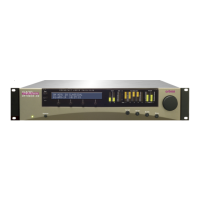5-6
TROUBLESHOOTING ORBAN MODEL 9400
duce loudness reduces peak limiting simultaneously, minimizing potential codec arti-
facts. Only turn down the output level control to correct codec clipping.
Loudness Decreases Momentarily When the Radio Crossfades between Ana-
log and Digital Channels
The
analog and digital channels may be in reverse polarity (“out of phase”) from
each other. Try both settings of the P
OLARITY control associated with the output driv-
ing the digital channel to determine which polarity causes a smoother crossfade. Do
not adjust the P
OLARITY control of the analog channel output because this will swap
positive and negative peak modulation.
Excessive Sibilance (“ess” sounds) in the Digital Radio Channel
The Band 5 compressor/limiter is mainly
useful as a de-esser and to prevent high fre-
quency artifacts when driving low bit rate codecs like the 36 kbps HDC codec used in
the HD AM system. To use the Band 5 compressor/limiter as a de-esser, set the B5
MAXDELTGR to OFF (to allow the channels to be de-essed independently), set the B5
DELTA RELEASE control to +6 (to achieve the fastest possible release), and set the
B4>B5
COUPLING control to 100% (to prevent high frequency energy from building
up excessively).
“Swishing,” “Phasing,” or “Underwater” Artifacts in the Digital Radio
Channel
Excessive
high frequency energy can cause this and can also cause gritty high fre-
quency distortion in digital channels that use a codec employing “spectral band rep-
lication” technology, such as the HDC (used in HD AM) and aacPlus (used in DRM)
codecs. To use the B5 compressor in the 9400’s digital radio processing channel to
control these artifacts, set the B5
MAXDELTGR to 0 (to minimize the amount of L–R
energy that the processing adds at high frequencies), set the B5
DELTA RELEASE con-
trol to 0 (to achieve a smooth integration with the Band 4 compressor), and set the
B4>B5
COUPLING control to 100% (to minimize high frequency energy build-up).
Then adjust the B5
THRESHOLD control to set the maximum amount of high fre-
quency energy that the processing can produce with bright program material. It is
wise to experiment with this control while listening to the output of the codec you
are using so you can hear the effect that the Band 5 compression has on codec arti-
facts.
General Dissatisfaction with Subjective Sound Quality
The
9400 is a complex processor that can be adjusted for many different tastes. For
most users, the factory presets, as augmented by the gamut offered by the L
ESS-
M
ORE control for each preset, are sufficient to find a satisfactory “sound.” However,
some users will not be satisfied until they have accessed other Modify Processing
controls and have adjusted the subjective setup controls in detail to their satisfac-
tion. Such users must fully understand the material in Section 3 of this manual to
achieve the best results from this exercise.
Compared to competitive processors, the 9400 offers a uniquely favorable set of
trade-offs between loudness, brightness, distortion, and buildup of program density.
If your radio station does not seem to be competitive with others in your market,
the cause is usually problems with the source material, overshoot in the transmission
link (particularly the transmitter/antenna system) following the 9400, or an inaccu-

